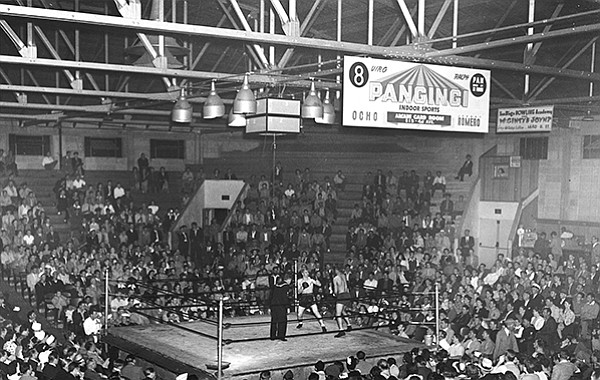
Por Joan Wojcik
East Village is steeped in San Diego history. Each of the many old buildings in East Village has a unique story to tell.
One such building is the Coliseum Athletic Club.
Many drive by the Coliseum without giving it a second glance or realizing its importance to the history of San Diego’s bygone days of boxing. The Coliseum appears indistinct from the many old buildings located in East Village but this building has a very illustrious past.
The Coliseum is located on the southwest corner of E and 15th streets. The only difference between the other worn out warehouses in the neighborhood is its domed roof. In the height of the Coliseum’s glory, from the 1920s until the 1930s, the domed roof would be filled with shouts from the many sports fans that enjoyed watching the boxing.

The domed, square-shaped building was often smoked-filled with an audience of over 3,500 boxing fans who sat on cheap fold-down seats in a stadium-style setting with the boxing ring in the middle of the floor.
Hollywood celebrities would often be in attendance for the boxing events and the Coliseum even had a visit from the infamous Al Capone.
The Coliseum was noted for giving many well-known boxers their initial debut into their boxing careers. One such notable boxer was James J. Braddock, whose life story was portrayed in the recent movie, “The Cinderella Man.”
Braddock boxed Dynamite Jackson at the Coliseum on Sept. 30, 1932, and won. He went on to become the World Heavyweight Champion when he won the match against Max Baer.
Other greats, such as Jimmy McLarnin, Tommy Loughran, Henry Armstrong, Ceferino Garcia, Archie Moore, and Ken Norton were headliners at the Coliseum. Both Moore and Norton would eventually call San Diego their home.
Moore, also known as Old Mongoose, had a lot of history tied to San Diego and the Coliseum. He started his professional boxing career in 1935 and boxed all but one bout that year at the San Diego Coliseum. His boxing career spanned the eras of Joe Louis, Rocky Marciana and Muhammad Ali, having fought all three legends.
Moore lived in San Diego from the 1960s until his death in 1998 but is remembered as starting his boxing profession at the San Diego Coliseum.
During the 1950s and ’60s, the Coliseum started losing its luster. Crowds began to dwindle and the Coliseum Athletic Club officially closed its doors Aug. 1, 1974. The property was eventually taken over by Jerome’s Furniture but has now sat empty for years.
Today, all that is left of the rich history of the Coliseum Athletic Club are four walls. The cheap seats, the boxer’s dressing rooms, the boxing ring, and the shouting are only memories of the once well-known boxing story of East Village.

According to Sam Patella, a lifelong friend of Jerry Navarra of Jerome’s Furniture, the only items salvaged from the inside the Coliseum were the luxury front row seats that were once occupied by the VIPs in the audience. Jerry Navarra is currently storing these chairs and hopes the chairs will be spotlighted in any future plans for the Coliseum.
What does the future hold for such a historical building?
The Coliseum will be included in the five-block community plan called Makers Quarter (see makersquarter.com).
As this five-block community plan evolves into a dense, urban mixed-use neighborhood, the Coliseum will become the focal point of a community gathering space.
“We are looking forward to the Coliseum once again being an exciting amenity and gathering space for the neighborhood,” stated urban planner, Stacey Pennington.
Patella believes the rebirth of the Coliseum will be soon. What venue will occupy this landmark site is yet to be determined but it will be exciting to look forward to the rebirth of the Coliseum in East Village.
— Joan Wojcik is the president of the East Village Residents Group. Learn more about the EVRG at or contact joan [email protected] o visitar evrgsd.org.







